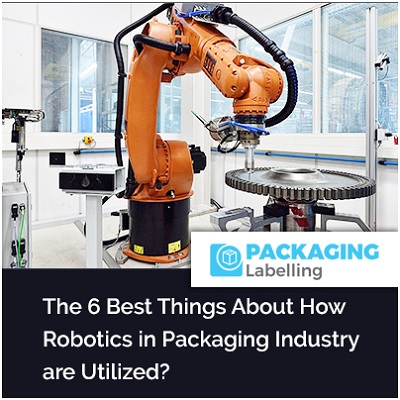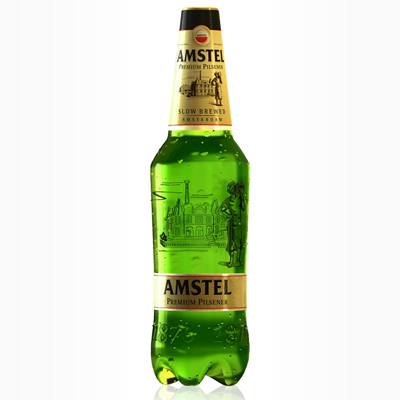Top 6 Robotic Applications in Packaging Industry | Packaging-Labelling

With the rise of Industry 4.0, a few organizations are deciding to add automation to their processes - and packaging processes are no exemption. This increasingly widespread method is driven by the similar reasons that automation and robotics were first brought to the manufacturing workplace - to eliminate errors, to free human workers from dangerous packaging task jobs, and to cut costs. Robotics is affecting each link in the supply chain, especially packaging. Robotics in the packaging industry is associated from the beginning to end-line, picking and placing, case packing, palletizing, and handling products.
Robotic technologies have paved their way and changed the processes in several industrial sectors including packaging. When it comes to innovation, the packaging industry is also very open-minded and enthusiastic to try out new things. Artificial intelligence has been steadily established in the packaging industry within packaging production and robotic technologies have even played a massive role for a long time. Automation is pushing the boundaries of technology to extreme new levels. It's a rising phenomenon where human labor is being replaced by robots and automated machinery. Unless something needs fixing, the latter doesn't get sick or slack off, besides can comparatively work faster than humans and their on-job performance is always productive, consistent, and free of repetitive induced errors.
| Also Read: Precision and Speed: The Evolution of Robotic Packaging Systems |
Robotic Packaging Machinery is usually preferred over humans as the machines overrun people in terms of accuracy, speed, and consistency. Robots can be effortlessly integrated into the packaging and shipping processes, reducing ergonomically risky work and speeding up the delivery times while also meeting the dynamic packaging needs of distributors, retailers, and customers. The high-speed packaging robots are noteworthy instruments for accomplishing targets and operational exactly, securely, and productively while likewise managing down the requirement for extended human intervention.
How Robotics in Packaging Industry are Utilized?
These days robotic packaging machinery can do more than ever. Enhance your productivity with robotic packaging machinery that packs, erects, and palletizes your packaging products.
A) Pick and Place
These types of robotic packaging systems are usually used in manufacturing but are also used in applications such as bin picking, packaging, and inspection. Some of the common applications for pick and place robots are -
- Assembly
- Packaging
- Bin Picking
- Inspection
There are quite a few types of pick and place robots like -
- Cartesian
- Robotic Arm
- Fast Pick
- Collaborative
- Delta
Speed and consistency are the main advantages in choosing these robotic packaging systems. These robotic packaging machineries are usually small in size and lightweight, suitable for use in applications where space is a constraint, are easily programmable, and can be used for multiple applications.
| Also Read: Innovative Solutions: Robotic Packaging in Modern Manufacturing |
B) Palletizing
Palletizing is tertiary packaging. It includes the arrangement of boxes and preparing them for shipping which is usually by stacking them on pallets. This is an extremely common application in the food and beverage industry. One particular benefit of having this robotic packaging system is it reduces worker injury. Some of the common applications for palletizing robots are -
- Handling pallets
- Slip sheets
- tier sheets
Some of the types of palletizing robotic solutions are:
- Case palletizing
- Bag palletizing
- Robotic depalletizing
- Scrap metal palletizing
- Mixed load palletizing
- Battery palletizing
The main advantages of choosing a robotic palletizer are it improves working conditions and employee safety, maximizes production speed, reduces operating costs, increases production flexibility, and also increases the quality of finished products on pallets.
C) Depanning
You would certainly be aware of these robotic packaging systems if you have baked cakes at home before. Removing items such as baked cakes or goods from the pan or containers could be very tricky and it must be executed with precision. The cakes that are baked and are mass-produced are usually prepared in large pans. And for this robotic arms can come in very handy and quickly remove items such as cupcakes or sheet cakes, from their pans without causing any damage and prepare them for primary packaging.
Robotic depanning often includes picking up an entire tray of baked goods using a particular depanning tool. Every baked product is grasped by a vacuum or by small pins.
D) Denesting
Denesting is about eliminating packages from a stack, to prepare for filling up with things, for example, other baked goods, or cupcakes. The process of denesting is carried in conjunction with robotic depanning. The process is repetitive and necessary. The package for the stack is taken away by the denesting process, while the depanning robot puts these baked cakes into it. Robots can do this efficiently and quickly. The biggest challenge one would face is to design a robotic packaging system that can process various products without taking large space. One solution that could be considered feasible is to use replaceable conveyors, but that would be too expensive.
E) Boxing
It's time to box the various items to prepare for shipment. The process of boxing includes picking up individually packaged products and grouping them into different boxes and cases. This is grouped under secondary packaging. The products in boxing are sealed from the environment. Therefore, there's no risk of contamination of the food. This type of task is convenient and simple to implement robotically. The robotic arms are agile enough to do this without damaging even delicate products like eggs.
In various secondary packaging applications, collaborative robots can be used which include the handling of special foods. These robots can be utilized to handle packages that are challenging to grasp.
F) Warehousing
The warehousing process starts once the products have been packaged properly. Transporting them in pallets with ease is the last task left. This can offer a competitive advantage to food warehousers. In particular, the food industry benefits from the speed, efficiency, and safety of automated warehousing. Besides, the process can be very labor-intensive especially when the numbers to be transported are huge. You can use Automated Guided Vehicles (AGVs) to transport packaged goods to streamline your warehousing processes. Also, you can use Autonomous Mobile Robots (AMRs) which are the latest versions of robots designed for warehousing applications.
There are many advantages of warehouse automation including greater accuracy and efficiency, extra space, and reduced costs.
Conclusion
For several years now, food packaging companies have been using robots in their processes. You can still use robots to automate each stage of your packaging process even if you run a small company. With this, your human workers can focus more on tasks that need critical thinking. And if you cannot afford big industrial robotic arms, you can use collaborative robots, which are smaller as they are suitable for automating tasks that deal with low production volumes.









